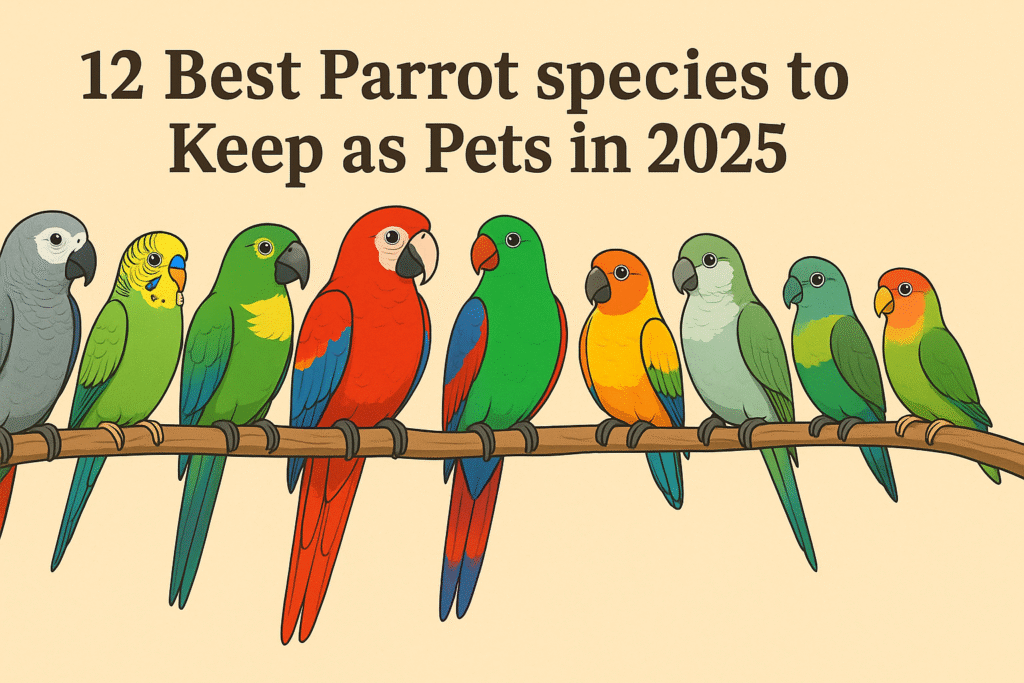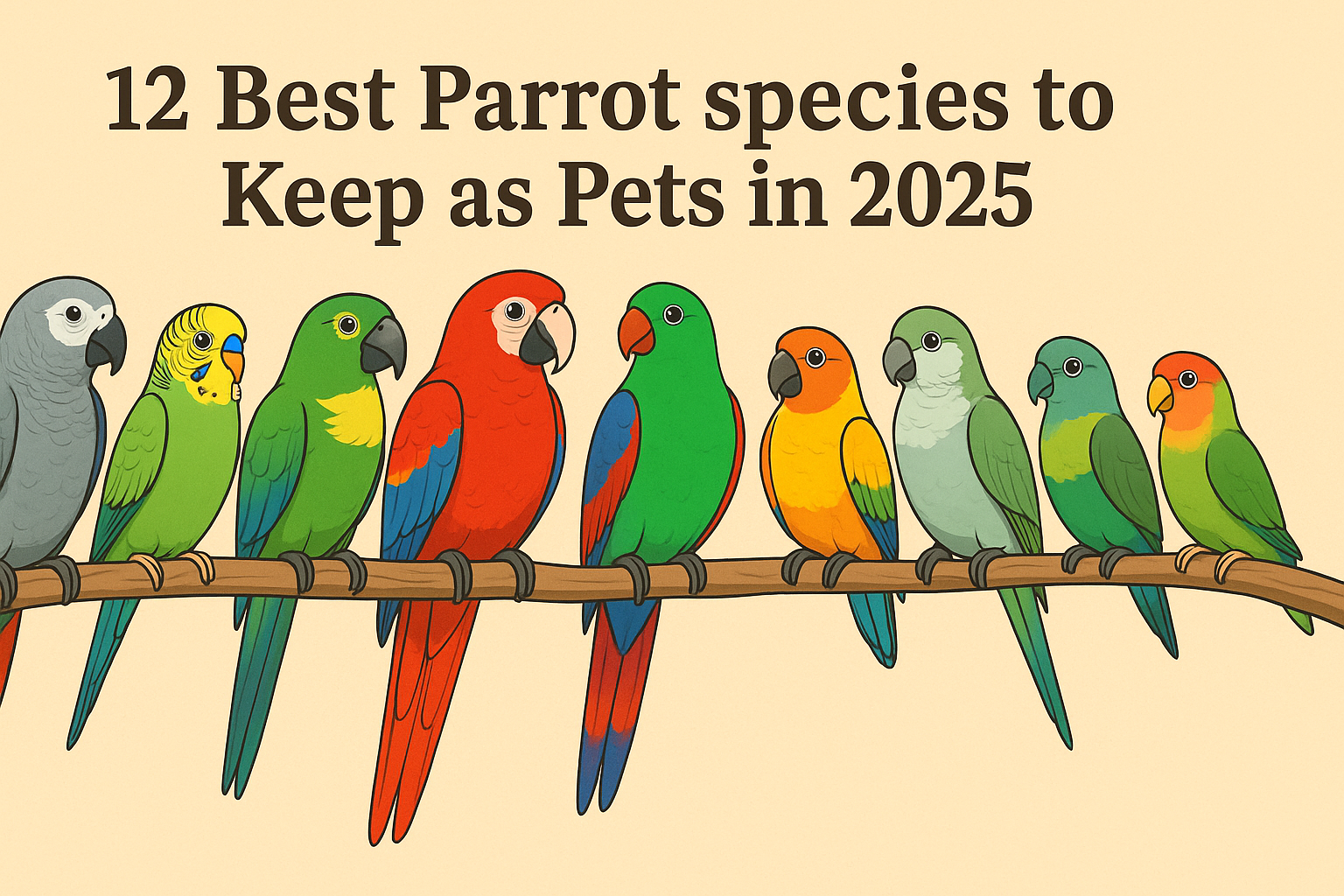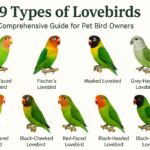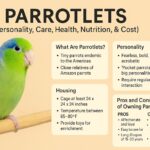Parrots continue to rise in popularity as household pets in 2025, captivating people with their vibrant colors, remarkable intelligence, and distinct personalities. While dogs and cats remain the most common pets globally, birds are steadily gaining ground as cherished animal companions. If you’re considering adding a feathered friend to your family, choosing the right species to match your lifestyle, experience level, and living situation is crucial for a successful relationship.
This comprehensive guide explores the 12 best parrot species to keep as pets this year, detailing their unique traits, care requirements, and what makes them stand out from the flock. From pocket-sized budgies to magnificent macaws, these birds offer diverse personalities and care needs to suit various bird enthusiasts.

12 Most Loved Types of Parrots
1. African Grey Parrots
African Grey Parrots stand at the top of avian intelligence charts. These medium-sized grey birds have earned their reputation as incredibly smart companions through their exceptional cognitive abilities and impressive vocabulary skills.
African Greys can learn hundreds of words and, notably, understand their contextual meaning. This goes beyond simple mimicry; these birds grasp what they’re saying, creating meaningful connections between words and situations. Their problem-solving capabilities often match those of young children.
While their intelligence makes them fascinating companions, it also means they require substantial mental stimulation. Without adequate engagement, African Greys can develop behavioral issues. These birds build deep bonds with their owners but need consistent interaction and attention.
With proper care, African Greys typically live 40-60 years, making them a lifetime commitment. Their unique combination of intelligence and companionship makes them highly sought after, despite the significant time investment they require.
2. Budgerigars (Budgies)
Budgerigars, commonly called budgies or parakeets, are the most popular pet birds globally for good reason. These small, colorful parrots pack enormous personalities into tiny frames, making them ideal for first-time bird owners or those with limited space.
Despite their small size, budgies are highly intelligent and can learn an impressive vocabulary. The world record for the bird with the largest vocabulary was held by a budgie named Puck, who could mimic an astonishing 1,728 words.
Budgies are naturally social, energetic, and playful. They thrive on regular interaction and quickly become tame with gentle, consistent handling. Their cheerful chirping brings life to any home without becoming overwhelmingly noisy.
Care for budgies is relatively straightforward. They need a cage allowing horizontal flight (at least 36 inches long), fresh food and water daily, and plenty of toys for mental stimulation. With proper care, budgies typically live 5-10 years.
Their combination of affordability, manageable size, and engaging personality makes budgies perfect starter birds for many households.
3. Cockatiels
Cockatiels rank close behind budgies in popularity and make excellent pets for both beginners and experienced bird keepers. As the smallest members of the cockatoo family, these charming birds are known for their distinctive crest feathers that express their emotional state.
Cockatiels are gentle, affectionate birds that form strong bonds with their caretakers. They’re especially known for their whistling abilities; many cockatiels learn to whistle tunes or mimic household sounds. While not as talkative as some other parrots, they can learn a limited vocabulary with patient training.
These birds are relatively quiet compared to many other parrot species, making them suitable for apartment living. Their calm demeanor makes them easier to handle than some more high-energy parrot species, though they still enjoy regular playtime outside their cage.
Cockatiels require a cage similar in size to budgies (minimum 36 x 24 x 24 inches) and thrive on a varied diet of high-quality pellets, fresh vegetables, and some seed. With proper care, cockatiels typically live 15-20 years.
Available in several color mutations, including the classic gray, pearl, pied, and cinnamon varieties, cockatiels make wonderful companions for bird lovers seeking a gentle, manageable parrot.
4. Amazon Parrots
Amazon parrots, with their striking colors and exceptional talking abilities, remain popular pets for those seeking an intelligent and interactive bird. The Yellow-Naped Amazon and Blue-Fronted Amazon are particularly sought after for their excellent speech capabilities and friendly dispositions.
These medium-sized parrots are known for their playful, outgoing personalities. They’re natural entertainers who love being the center of attention, often performing “dances” and vocalizations to amuse their human companions. Their clear speech and ability to learn extensive vocabularies make them incredible talkers.
Amazon parrots form strong bonds with their owners and require daily interaction. They’re highly social creatures that can become depressed or develop behavioral problems if left alone too often. Their boisterous nature and occasional loud vocalizations make them better suited to houses rather than apartments.
With lifespans of 40-50 years or more, Amazon parrots represent a significant long-term commitment. They require spacious cages, plenty of toys to challenge their intelligent minds, and a varied diet of high-quality pellets, fresh fruits, and vegetables.
Due to their strong personalities and specific care needs, Amazon parrots are generally recommended for experienced bird owners rather than beginners.
5. Macaws
Macaws are the gentle giants of the parrot world. With magnificent colors and impressive size, these birds make a striking impression in any home. The Scarlet Macaw is among the most popular varieties kept as pets.
These large parrots are brilliant problem-solvers with the ability to learn complex tricks, mimic human speech, and even use tools. Their intelligence requires substantial mental stimulation through toys, puzzles, and regular training sessions.
Macaws form extraordinarily strong bonds with their caretakers and require daily attention and interaction. They’re known for their playful nature but can be quite loud, making them unsuitable for apartment living or noise-sensitive households.
Due to their size, macaws need exceptionally large cages or aviaries. The minimum recommended cage size is approximately 60 x 36 x 60 inches, though larger is always better. They also require sturdy toys that can withstand their powerful beaks.
Perhaps the most significant consideration with macaws is their impressive lifespan, which commonly reaches 50-70 years, with some individuals reportedly living over 100 years. This extraordinary longevity means they often outlive their original owners, requiring advance planning for their future care.
6. Eclectus Parrots
Eclectus parrots stand out for their extraordinary appearance; males display bright emerald green feathers, while females showcase stunning scarlet and purple plumage. This dramatic difference in coloration between sexes is unusual in the parrot world.
Beyond their striking appearance, Eclectus parrots are highly intelligent and talkative. They typically develop clear speech and can learn extensive vocabularies with regular training. Their calm, gentle nature makes them easier to handle than some other large parrot species.
Eclectus parrots have unique dietary requirements compared to other parrots, needing a diet higher in fruits and vegetables. This specialized diet must be carefully maintained to prevent health issues specific to the species.
These birds form strong bonds with their caretakers but are generally less demanding of constant attention than some other large parrots. They enjoy quiet interaction and mental stimulation through puzzles and training sessions.
With a lifespan of 30-50 years, Eclectus parrots represent a significant long-term commitment. Their unique combination of beauty, intelligence, and relatively calm demeanor makes them increasingly popular pets for experienced bird owners.
7. Conures
Conures are medium-sized parrots known for their playful, energetic personalities and spectacular plumage. These vibrant birds come in a variety of species and colors, making them visually appealing pets.
These birds are social, clever, and full of energy. While not the best talkers among parrots, they excel in learning tricks and playing games. Their acrobatic antics and playful nature make them entertaining companions who bring life and laughter to their homes.
Conures are very social birds that need daily interaction with their human flock. They form strong bonds with their owners and enjoy being included in family activities. Without adequate attention, they can become noisy and develop behavioral problems.
These parrots have moderate space requirements compared to larger species. They require a variety of toys that allow for climbing, chewing, and foraging behaviors to keep them mentally stimulated and physically active.
Conures typically live 20-30 years with proper care. Their combination of manageable size, striking colors, and playful personalities makes them popular pets for those who can accommodate their social needs and occasional loudness.
8. Quaker Parrots (Monk Parakeets)
Quaker Parrots, also known as Monk Parakeets, have gained popularity due to their intelligence, speaking abilities, and relatively affordable price compared to other parrots with similar capabilities. These medium-sized green birds with gray faces and chests are known for their unique nest-building behavior, even in captivity.
Quakers are excellent talkers who can develop vocabularies of dozens of words and phrases with clear pronunciation. They’re highly social, forming strong bonds with their caretakers and showing affection through interaction.
These parrots are known for their problem-solving intelligence and can learn tricks quickly with consistent training. However, they’re also known for their strong personalities and can become territorial about their cages or certain areas of the home.
Quaker Parrots typically live 20-25 years and require adequate space for movement and play. They’re avid chewers, so owners must provide plenty of safe toys and branches to protect furniture and valuables.
It’s important to note that Quaker Parrots are prohibited in some states and regions due to concerns about establishing wild colonies. Potential owners should check local regulations before considering this species.
9. Indian Ringnecks
Indian Ringneck Parakeets have grown in popularity as pets due to their striking appearance, intelligence, and excellent talking ability. Males develop a distinctive black ring around their necks after maturity, while females typically remain ring-free.
These elegant, slender parrots are quick learners with exceptional talking abilities. With consistent training, Indian Ringnecks can develop vocabularies of many words and speak with remarkable clarity. They’re also capable of mimicking household sounds and learning tricks.
Indian Ringnecks require regular handling from a young age to become tame and bonded to their caretakers. Without proper socialization, they can become nippy or distant. However, well-socialized birds form strong bonds with their owners while maintaining an independent streak.
These birds need spacious cages and plenty of toys to keep their intelligent minds occupied. They enjoy learning new tricks and solving puzzles, requiring mental stimulation to prevent boredom.
With lifespans of 25-30 years, Indian Ringnecks represent a significant commitment. They’re often recommended for experienced bird owners who understand their need for consistent handling and training.
10. Meyer’s Parrots
Meyer’s Parrots might be less well-known than some of their more colorful cousins, but they’re gaining popularity as pets thanks to their gentle temperament and manageable size. These African parrots sport predominantly green plumage with variable amounts of yellow and blue markings.
Unlike many other parrot species, Meyer’s Parrots are known for their relatively quiet nature, making them suitable for apartment living or shared housing situations. They’re intelligent and can learn to mimic words and sounds, though they’re generally not as talkative as some other species.
These birds are calm, intelligent, and enjoy gentle interaction with their caretakers. They’re less demanding of constant attention than many other parrots while still forming strong bonds with their human companions.
Meyer’s Parrots require standard cage sizes for medium parrots and enjoy a variety of toys for mental stimulation. They have relatively straightforward care requirements, making them suitable for dedicated beginners as well as experienced bird keepers.
Their quiet, easygoing nature makes them perfect for calmer households seeking a parrot companion without excessive noise.
11. Parrotlets
Often described as “big birds in tiny bodies,” Parrotlets are the smallest parrots commonly kept as pets. Despite their diminutive size at just 7-12cm long, these birds possess the temperament and intelligence of much larger parrots.
Pacific Parrotlets and Green-rumped Parrotlets are the most common species in the pet trade. These tiny birds come in various color mutations, though green is the natural coloration. Males and females display different coloration, making it easy to determine gender in mature birds.
Parrotlets are surprisingly confident and may challenge much larger pets or even people if they feel threatened. Early socialization and consistent handling are essential to develop a tame, friendly bird.
While they can learn to mimic some words and sounds, Parrotlets aren’t known for extensive vocabularies. Instead, they charm owners with their big personalities, playful antics, and affectionate behavior toward their favored people.
These tiny parrots need appropriately sized cages with proper bar spacing to prevent escape. Though small, they still require plenty of toys and regular time outside their cage for exercise and bonding.
Parrotlets typically live 20-30 years, making them a significant commitment despite their small size.
12. Lovebirds
Appropriately named, Lovebirds are small parrots known for the strong bonds they form with their mates or, in captivity, with their human companions. These African natives come in a variety of species and color mutations.
Lovebirds have energetic, playful personalities and enjoy interactive play with their caretakers. While not typically talented talkers, they communicate through a variety of chirps, whistles, and body language. Their amusing antics and affectionate nature make them endearing companions.
These small parrots form strong attachments to specific people and may become jealous or territorial with others. Hand-raised lovebirds typically make the best pets, as they bond more easily with humans than parent-raised birds.
Lovebirds require cages that allow for horizontal movement and play. They’re notorious for their paper-shredding behavior, often tucking strips of paper into their feathers when nesting. This natural behavior should be accommodated with safe shredding materials.
Their combination of affectionate nature, compact size, and reasonable lifespan makes them suitable pets for dedicated beginners interested in forming a close bond with a small parrot species.
Conclusion
Selecting the right parrot as a pet requires careful consideration of factors including lifespan, noise level, space requirements, and the time you can dedicate to interaction and care. Each species offers unique characteristics, from the impressive intelligence of African Greys to the manageable size and energy of Budgies.
Remember that all parrots, regardless of species, are highly social creatures that need daily interaction and mental stimulation. They’re not decorative cage fillers but intelligent beings that require commitment and respect for their natural behaviors and needs.
Before bringing any parrot into your home, research thoroughly, speak with experienced owners, and if possible, spend time with the species you’re considering. Many parrot rescues allow volunteer opportunities that provide valuable experience with different species.
Parrot ownership brings tremendous joy and companionship, often lasting decades. By selecting a species that aligns with your lifestyle and expectations, you’ll create the foundation for a rewarding relationship with one of nature’s most intelligent and engaging creatures.
Keeping a pet bird comes with significant responsibilities, as they have specific care requirements. Also, having pet birds is a lifelong commitment. Always check the rules and regulations in your area before getting a feathered companion.
- Parrotlets (Personality, Care, Health, Nutrition, & Cost) - June 20, 2025
- Caique (Personality, Care, Health, & Nutrition) - June 20, 2025
- The Complete Guide to Golden Retrievers - June 9, 2025















